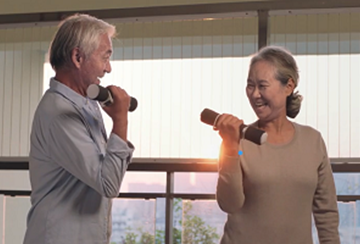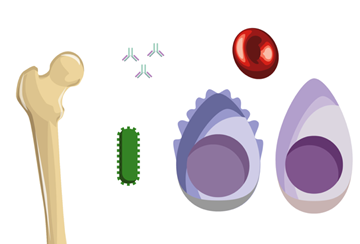A few little things can add up to better bone health
There’s no question that Canadians have been shaken from their usual routines. Now, as hope of life getting back to normal appears on the horizon, perhaps it’s time to establish new ones.
Habits that promote healthy bones would be a smart place to start. Osteoporosis causes bones to become thin and porous, decreasing bone strength and leading to an increased risk of fracture.1 Osteoporotic fractures put your good health and well-being in jeopardy — there’s evidence that fragility fractures even increase one’s risk of dying2.
The good news is that we can take care of our bones and reduce our risk of serious consequences from osteoporosis by adding a few little routines to our lives3 — modest adjustments to the way we eat, move around, and talk to our healthcare providers.
Two essential nutrients for osteoporosis prevention
To consume a diet that promotes good bone health, you have to be mindful of two essential nutrients, namely calcium and Vitamin D4.
Regarding calcium, adults between the ages of 19 and 50 need 1,000 milligrams of it per day, while the recommended figure rises to 1,200 milligrams for those over 50, according to Osteoporosis Canada.5 What does that mean in practice? That it’s important to have a balanced, healthy diet.
That can sound like a tall order, but a few little menu additions can go a long way toward osteoporosis prevention and good bone health.
Some people strongly associate calcium with dairy, and while it’s true that many dairy foods are rich in calcium, there are great sources in other categories as well. A cup of fortified orange juice, for example, contains 300 milligrams a serving. So does a serving of fortified rice, soy or almond beverage. Adding beans and canned sardines or salmon to a meal will also boost your calcium intake.6
As for your daily Vitamin D requirement, the recommended amount depends on a few factors including age, pregnancy and fracture risk. Your doctor can help you determine your needs. Both Health Canada and Osteoporosis Canada recommend that adults take a routine vitamin D supplement because there are very few good food sources of vitamin D.7,8
A little exercise for healthy bones
There’s some evidence that exercise can help prevent osteoporosis in older adults,9 but how much should you do? Osteoporosis Canada guidelines call for a pretty modest amount of exercise across a few categories of movement, including: strength training at least two days per week, simple posture awareness exercises every day, and 150 minutes of aerobic exercise each week — which works out to a little more than 20 minutes a day10.
Exercises of these kinds are recommended for people who have osteoporosis as well as those who don’t.
If you do have osteoporosis, or have experienced a spine fracture, an international panel developed the Too Fit to Fracture program to provide a series of recommended exercises that may suit your needs.11
A short conversation with your doctor — and a quick assessment
Starting an ongoing conversation about bone health with your healthcare providers is another small measure of osteoporosis prevention in terms of effort. But it’s an important one all the same, especially if we’re over 50 — or younger, if you exhibit certain risk factors associated with low bone density and fractures, including fracture after age 40, early menopause, low body-mass index (BMI), and rheumatoid arthritis12,13,14.
If you talk to your doctor about bone health at your next visit, they may invite you to take a FRAX osteoporosis risk assessment test. That’s a questionnaire that healthcare professionals use to estimate your 10-year risk of an osteoporotic fracture as well as a risk of a hip fracture. It only takes a few minutes to complete.
Once again, it doesn’t take too much time or effort to think about your long-term bone health. So why not get started today?
- https://osteoporosis.ca/about-the-disease/fast-facts/
- https://www.amgen.ca/sciencedispatch/health-and-wellness/fracture-risk-and-mortality-following-a-fragility-fracture/
- https://www.nof.org/preventing-fractures/prevention/
- https://osteoporosis.ca/bone-health-osteoporosis/calcium-and-vitamin-d/
- https://osteoporosis.ca/bone-health-osteoporosis/nutrition/calcium-requirements/
- https://osteoporosis.ca/bone-health-osteoporosis/nutrition/calcium-requirements/
- https://osteoporosis.ca/bone-health-osteoporosis/calcium-and-vitamin-d/vitamin-d/
- https://www.canada.ca/en/health-canada/services/food-nutrition/healthy-eating/vitamins-minerals/vitamin-calcium-updated-dietary-reference-intakes-nutrition.html [see very last paragraph]
- https://link.springer.com/article/10.1186/s12966-020-01040-4, page 50
- https://osteoporosis.ca/bone-health-osteoporosis/exercises-for-healthy-bones/
- https://osteoporosis.ca/about-too-fit-to-fracture/, http://www.osteoporosis.ca/wp-content/uploads/OC-Too-Fit-to-Fall-or-Fracture.pdf?_ga=2.75972373.1070168830.1621344816-293393322.1618930027
- https://www.mayoclinic.org/diseases-conditions/osteoporosis/symptoms-causes/syc-20351968
- https://pubmed.ncbi.nlm.nih.gov/17125421/#:~:text=Conclusions%3A%20Women%20with%20low%20BMI,to%20maintain%20a%20normal%20weight. (last paragraph, it won’t let me highlight)
- https://osteoporosis.ca/about-the-disease/fast-facts/





